
20 December 2000...February 2001
(24 pgs.)

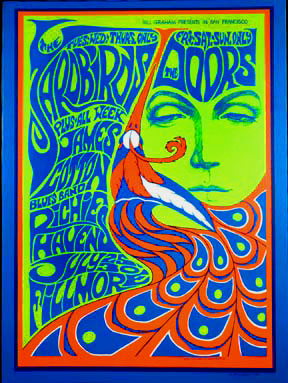
TITLE:
Here is a definition of Metaphor
a figure of speech in
which an expression is used to refer to something that it does not literally
denote in order to suggest a similarity
The transference of the relation
between one set of objects to another set for the purpose of brief explanation;
a compressed simile;
e. g., the ship plows the sea. --Abbott & Seeley.
``All the world's a stage.'' --Shak.
Note: The statement, ``that man is a
fox,'' is a metaphor;
but ``that man is like a fox,'' is a simile,
similitude, or comparison.
Taken from Hyperdictionary
The
extra "E" in the title is because Metaphore is yet another jumbling of all the
letters in Promethea.
Note that another possible title for this issue could
be "The Magic Theatre of the Mind"
I've been waiting for a couple of years now for someone to ask me how on earth we did Promethea #12, just so that I could be knowing and mysterious about it, rather in the style of David Blaine. On the other hand, I think the actual process by which we accomplished it is failry mysterious even if I explain, step by step, exactly how we did it. The inital germ of the idea was a specific issue of the old Sixties British Underground magazine OZ. This particular issue, the Magic Theatre

eschewed the presentation of articles and cartoons in separate blocks of
pages, and instead opted for this relatively unique approach where articles,
cartoons and other visual progressions of material were strung out through the
entire issues, so that you kind of had to read three or four discrete and
distinct strands at once, rather than read four linear articles or features on
after another, in the usual way. It struck me that it might be possible to do
something similar in Promethea, only much more integrated and structured witin
that basic framework.
- Alan Moore interview in Egomania #2, pg 24
SYNOPSIS
A tour through the 21 major arcana cards of the tarot with
Mack and Mike the 2 snakes from Promethea's caduceus explaining things to
her
Variations on P R O M E T H E A
If you would like to see the grand total of 178 words that can be made as
anagrams from Promethea (minimum 2 letters long) click here
And
ditto for Alan
Moore
QUOTES
“Here is revealed, for all to see,
The magic of
reality
Conversely, we may also view
Reality in magic, too” – Mike, pg
first
“This reckless step from naught to one
It’s magic’s foremost tick, I
guess,
How something comes from nothingness” – Mack, pg 0
“Railway
carriage?”
Are you sure that’s part of this train of thought” – Promethea, pg
I
“What you’re implying is that all these tarot pictures represent a coded
history of … everything?” – Promethea, pg III
“I’m having trouble keeping the
different threads separate. I’m not even sure which of you two is which…-
Promethea
“It’s like a fugue: You have a choice
Of following a single
voice,
Or letting each strand grow less clear
The music of the whole to
hear”- Mack, pg V
[Adam & Eve] “That they’re amoebas is implied
By
Eve, grown from her husband’s side” – Mack, pg VI
“Then what you’re saying is
that everything in our culture, including language and art, arose from the
drugged-out insights of the first magicians” – Promethea, pg
VIII
“Initiation, it’s implied
May be a dark and desperate ride
A
journey through the land of shade
Required before progress is made” – Mike,
pg XII
“Death, our eventual, awful fate
Means nothing more than ‘change of
state’” – Mike, pg XIII
“A pentacle surmounts his frown
With four points
up and one point down:
Four elements of matter rise
While spirit,
downmost, trampled lies” – Mike, pg XV
“The devil is, then, by and
large,
Materialism’s fierce mirage” – Mike, pg XV
“Materialism’s steady
creep
Which William Blake, called ‘Newton’s Sleep’
Brings worldly
blessings, fair and fine
Yet blinds mankind to the divine” – Mike, pg
XV
“The Renaissance ushered in the age of reason, which replaced Spirituality
with Materialism. I guess that’s when the human agenda changed from vague
notions of spiritual progress to measurable physical advances”- Promethea, pg
XVI
“So, too, Materialism’s soar
Is struck down by the First World
War
It’s lightning forked from Europe’s skies,
Arrests the industrial
ideal’s rise” – Mack
“Its dream, its vision, its great plan
Of technology
serving man
Here sours and founders, ends in blood,
In poppies, wire and
Flanders mud” – Mike, pg XVI
“All men raise towers that crash and burn
And
break their hearts, yet never learn” – Mike, pg XVII
“In a bereaved world of
wrecked lives
Faith in the Occult, clearly, thrives” – Mike, pg
XVII
“Materialism ends, ‘Twas found,
In bleached young bones on foreign
ground
Tiring of war maps, mankind’s led
To chart the spectral realm
instead” – Mike, pg XVII
“Occult philosophies define
The territory of the
divine” – Mack, pg XVII
“This twenty-two card tarot set
Matches the Hebrew
alphabet” – Mack, pg XVIII
“Humanity’s every glimmer of spiritual insight
seems to eventually deteriorate into darkness and conflict…but when our material
situation grows unbearable, that forces mankind towards spiritual rediscovery,
as a counter-reaction” – Promethea, pg. XIX
“Youth, by the century’s middle
years
outnumbers age, seeks new ideas” - Mack, pg XIX
“Youngsters, still
wet behind the ears
Took on the roles of bards or seers” – Mack, pg
XIX
“Apocalypse, as ‘world’s end’ seen
Need only revelation mean” – Mike,
pg XX
“Man’s knowledge doubles, it appears
Just less than every couple of
years
Man’s last two years more breakthroughs see
Than all your previous
history” – Mack, pg XX
“Mankind moves from the earthly plane
To moon’s
imaginary domain” – Mack, pg XXI
“Imagination’s endless dance
Is mankind’s
jewelled inheritance” – Mack, pg XXI
“Thus does our serpent’s tale
conclude
(or starts fresh, if you’re in the mood)
Around and round our
fable goes
Eternal like ouroboros.” – Mack, pg last
NOTES & ANNOTATIONS
Firstly a quote from Alan Moore
specifically about this issue
I'd have to say that were someone to put a
gun to my head (Americans note that this is a figure of speech and not an
example of acceptable social behaviour) and demand to know what I thought was my
single cleverest piece of work, I'd have to say Promethea #12.
taken
from Egomania #2
Another quote from Alan about this issue taken from the Afterwords to Alan
Moore's Writing for Comics pg. 46
Promethea #12 with a structure so
intricate and unlikely that I'm still not entirely sure how we accomplished
it
Secondly a good review of this issue.
If
you look carefully you will notice that when Mike speaks the speech bubbles have
a green frame and when Mack speaks the speech bubbles have a red frame.
NOTE:
instead of the usual numbering for this issue I will simply refer to the Tarot
Card Number given to each page.
The following Tarot card numbers are
partially or totally obscured: VI, XI, XIII, XX
This whole issue is an
example of Eternal recurrence like Pink Floyd’s The Wall or James Joyce’s Finnegans Wake to give 2 other examples
from the 20th century.
If you purchase a second copy of this issue or have a
color photocopier then you can turn the entire issue into one long continuing
panel stretching for 24 pages with page 1 and page 24 connecting up to each
other to make it an endless story with no beginning and no
end.
Note:
Angel descending on right hand side of pgs. 1-23.
Devil
ascending on left hand side of pgs 2-24.
Both angel and devil seen on pg.
VIII Adjustment.
Hebrew letters instead of number scores on Scrabble letters
except for pgs. 1 & 24. Where they are replaced by the 5 pointed
star.
Cards are based on the Book of Thoth otherwise known as
the Crowley designed Freida Harris painted set.
On the bottom of each panel
is Aleister Crowley telling us a story and shown from birth to
death.
Promethea appears at least once on every double page spread and 5
times between X and XI
Chequerboard pattern appears at top of page on all
pages and starts breaking apart between pages 23 and 24.

Here is the Hebrew Alphabet useful for
interpreting the Kabbalah and Tarot.
Please note that most of the Crowley
photos are taken from here

Page first:
The back of the Tarot deck is seen on this page.
Promethea is just about to pick a card from the deck as per Mike and Mack's
instructions.
At the bottom of the page we see a sperm fertilizing an egg and
a foetus starting to form. This is the conception of none other than Aleister
Crowley.
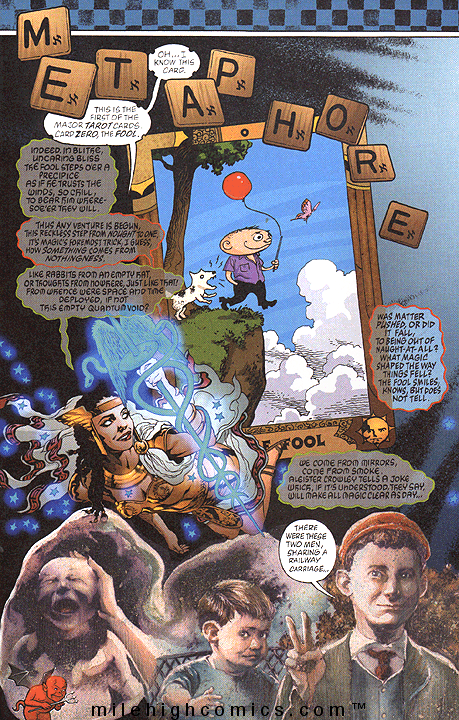
Page 0 Down on the bottom of the page we see Crowley born and then as
a small child and finally as a schoolboy making the Peace or V for Victory
sign.
The relevant passage about the V sign comes on pgs 386-387 of Lawrence
Sutin's Do What thou Wilt biography.
Once the war began the Beast was
passionate in his support of the British cause. If immitation is the sincerest
flattery, then Crowley paid great homage to Winston Churchill...by posing for
photographs in which clad in bowler hat with scarf, cigar and contemplative
scowl, he struck a striking resemblance to Churchill himself. Crowley also
claimed to have originated the popular V for Victory hand gesture employed by
Churchill. According to Crowley, the letter V was suited to the task of bringing
victory due to its numerous esoteric correspondences. Crowley's claims have
never been accepted; David Ritchie of the British Broadcasting Corporation is
widely credited as having suggested it to Churchill.
Adapted from this
photo of Crowley taken in 1889 when he was just 14

This image also inspired Alan Moore's From Hell Chapter 9 pages 3-4

Page I Tarot card shows the Magus with his four magical
instruments
Note the pen replacing the wand in the air. The magus holds a
stage magicians' magic wand in his hand and is dressed like innumerable stage
magicians from this century with top hat, tails and a moustache.
The pen that
Barbara gave Sophie has been transformed into her caduceus whenever she changes
into Promethea.
Aleister Crowley seen in same pose as a famous photograph of
him:



was brilliantly and deeply explored in the "Prelude ... Ant fugue" chapters from Douglas R. Hofstadter's incredible "Godel, Escher and Bach".
In reading those chapters, they become the pretty obvious source for Alan
Moore's observations. Of course, it must have been some sort of unconscious
quotation, but it's there anyway.
From Hutchinson Encyclopedia
Lucy
was the name give to a skeleton found in east Africa. A member of the species Australophithics
afarensis.
A young Crowley continues the story with a goat, a mastadon
and some apes behind him.
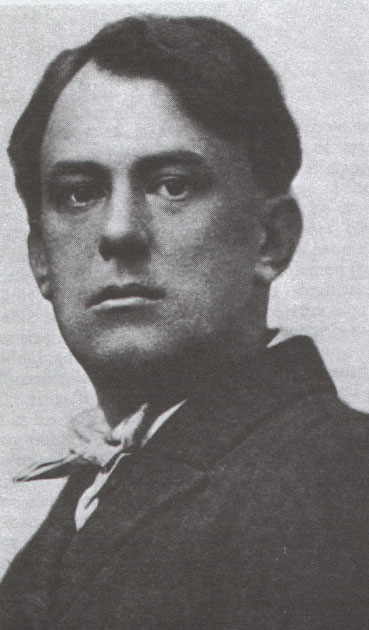
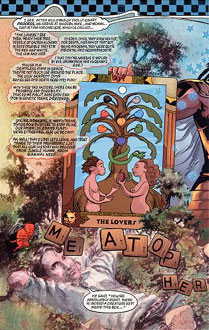



Behind him statues engaged in warfare to his left and making love to his
right.
The largest of the 5 Prometheas totally obscures the Tarot Card number
XI.
Tarot card is called Lust and represents a naked woman holding a wand and
an overflowing cup riding on the back of an angry lion whilst a city is
destroyed in flames as the moon shines on smilingly.
Pages XII-XIII
Crowley is starting to get older.
This seems the most likely source for
Crowley's image as depicted on these two pages:

Page XII: Buckminster Fuller.
The
hanged man hangs upside down from a chain but doesn't seem too concerned about
it. Behind him a city is in flames. The Moon shines on.
Behind Crowley and to
his right statues of the two lovers from the previous page have another woman
holding on to the man.
The painting behind Crowley is adapted from the
Hieronymous Bosch panel depicting Hell in his triptych:
The Garden of Earthly
Delights.
Note that the bladder shaped red pink outline is repeated in a
small white square on top of Crowley's left hand.


Page XV
The phrase the Age of Reason comes from an essay by Thomas Paine.
Newton's sleep -
A phrase coined by poet William Blake, Newton's sleep refers to the preference
of a mechanical view of the universe over a spiritual view.
It comes from a
poem he wrote in a letter to Thomas Butts:

The Tarot card depicts the Devil as a mischevious boss forcing a man and
woman to mop a floor whilst chained at the neck.
Behind Crowley are wheels
and cogs that seem to interact with each other.
Page XVI
Babel
Tower of Babel
The Tower of Babel and the confusion
of languages
Crowley now looking older still.
More wheels and cogs
behind him and to his left some nice red flowers break the two pages up from
each other.
The Tower has been struck by lightning and 3 people fall from it.
The eagle with lightning rods looks very reminiscent of Nazi imagery.
Page
XVII
Angels of
Mons
Theosophy
Fairies
snapped at Cottingly
Photos and transcripts
Golden Dawn
Crowley
watching the sunset smoking a cigarette.
The Star Tarot Card. A half naked
woman spills some liquid into the ocean. Note that the ground she sits on seems
to depict a map of the entire world. The normal Tarot image for this depics the
woman with one foot on the ground and another in the water but here it looks
like she only has her knee on the ground just beside the water.
Page XVIII
and XIX

Page XVIII:
Auschwitz
Hiroshima
Underworld of
Hecate.
"HEKATE,
the UNDERWORLD GODDESS of witchcraft, was the only child of the Titanes Perses
and Asteria. From her parents she inherited powers over the earth, sea and
heavens.
Hekate assisted Demeter in her search for Persephone and after their
reunion became Persephone's minister and companion in Hades.
She was closely
associated with ELEUSINIAN Mysteries. Hekate was usually depicted in vase
paintings holding two torches. In statuary she was sometimes depicted in triple
form"
Hekate and the rites of Eleusis appear in Alan Moore's Glory # 1
(Avataar December 2001) in the origin story of Glory (drawn by Melinda Gebbie)
and Glory # 2 (Hecate shown as an old woman with white hair, sitting in a cave
and holding a caduceus).
Unfortunately no more issues were published after #2
and the story remains unfinished.
Tarot card for the Moon. Man walking towards us passing a gateway reading Arbeit Macht Frei which
translates from German as:
Work Liberates.
It is written above the
wrought iron gates at Auschwitz.
Behind the man an atomic mushroom cloud is
seen. The Moon doesn't look too happy. On the ground just behind the man is the
hammer and the sickle.
Crowley wears a turban looking similar to this picture
but without the pipe and perhaps a bit younger:
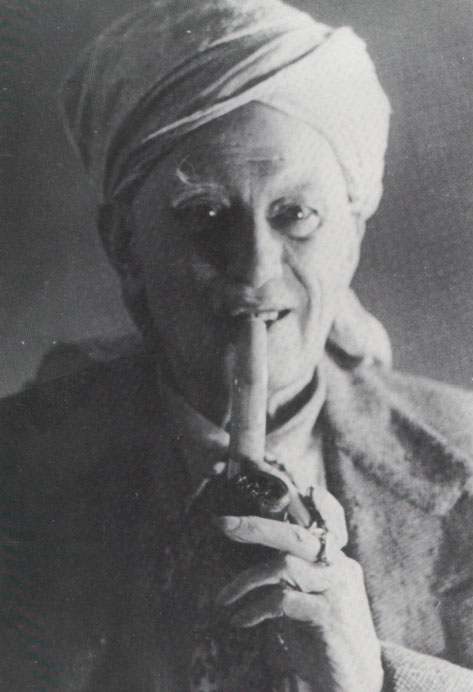
Behind Crowley some Swastikas and a
nuclear sign.
Page XIX
Buddhism
Zen
Astrology
I-Ching
Psychedelic:
adjective.
Of, characterized by, or generating hallucinations, distortions of
perception, altered states of awareness, and occasionally states resembling
psychosis.
noun.
A drug, such as LSD or mescaline, that produces such
effects.
[psyche1 + Greek dloun, to make visible (from dlos, clear, visible.
See dyeu- in Indo-European Roots) + -ic.]
Zeitgeist:
The spirit of the
time; the taste and outlook characteristic of a period or generation: “It's easy
to see how a student... in the 1940's could imbibe such notions. The Zeitgeist
encouraged Philosopher-Kings” (James Atlas).
[German : Zeit, time (from
Middle High German zt, from Old High German. See d- in Indo-European Roots) +
Geist, spirit; see poltergeist.]
Crowley with a walking cane.
Behind him
some blue peace signs (also used as anti-nuclear signs)
and some sigils and a magic square. Also a city (maybe New York) behind
him.
Tarot card for the Sun. Two little hippies dancing naked on a green hill
as the sun looks down benignly. Note the flowers have coloring reminiscent of
the Rosicrucian symbol.
Page XX
The snakes Mack and Mike and the
caduceus obscure the number XX.
2017 only another 14 years to go.
"As
Craig Barrett, executive vice president and chief operating officer, explained,
Intel continues to adhere to Moore's Law,
which states that the number of transistors per chip doubles every 18 months.
The company predicts that silicon scaling will reach its physical limit by the
year 2017."
Source: Cade Metz, "Intel Pushes Pentium Pro," PC Magazine,
August 1996, p. 36.
Harpocrates -
Horus the child. God of silence and secrecy. His cult, combined with that of
Isis and Serapis, was very popular in the Roman Empire.
Some more information
about Harpocrates.
Here
is a statue of Harpocrates.
Crowley ill in bed in his declining days.
Around him more peace signs but
also Egyptian
ankhs as well as an eye in the triangle and a female from some alchemical
sketch.
More information about Ankhs.
Tarot Card the Aeon with Harpo Marx making the
sign of silence whilst blowing his bicycle horn "Ankh Ankh"as smiling ghosts
rise from their graves.
Page XXI AC Dying from pencil sketch by Lady
Freda Harris Nov. 30, 1947.
He died on Dec 1st.
Tarot
card The Universe very similar to Crowley/Harris image.
Promethea flies off
as the issue comes to a conclusion
Quoting from Lawrence Sutin's 2000
biography of Aleister Crowley Do What Thou Wilt:
Crowley died on
December 1, 1947 from myocardial degeneration coupled with severe
bronchitis.....John symonds recorded that "Frieda Harris told me that Crowley
died unhappily and fearfully. She held his twitching hands while the tears
flowed down his cheeks. 'I'm perplexed' he said. She was not with him at the
very end.
.....but As one might expect there are different accounts of
Crowley's last words and moments.
According to [Patricia] McAlpine, Frieda
Harris had not come to visit at the end, and there had been no scenes of
weeping.
pgs. 417 & 418.
Thanks to Jose Villarubia for send
me the following interview excerpt from Blather
magazine:
Q:What are your thoughts on Crowley the
man?
A:I think that he was a brilliant scholar. I think that it's
difficult to make a judgement of Crowley, mainly because he himself did almost
everything he could to obscure his - I mean, he played up to all the rumours and
the notoriety and for a while I think he thought "Oh well, all publicity is good
publicity." It didn't actually work out like that.
Q:He had a very
painful end.
A:Well, it depends. I tell you, I've got a great little
picture. Well, it's only in a catalogue, it's a reproduction. I went down to
that Crowley exhibition that they had a couple of years ago in London. They'd
got a load of his paintings. And they'd also got paintings by Frieda Harris. And
they'd got, yeah, a couple of originals from the Thoth deck, which were nice to
look at, quite interesting to see. They'd also got this little pencil drawing
called A.C. Dying by Frieda Harris. A little pencil drawing of this frail,
skeletal guy with a wispy beard, sunk in the pillows of his bed, eaten away,
consumed by his illness and he's got one finger, just touching his bottom lip.
And when you hear of the alleged Crowley's last words, "I am perplexed," then -
yeah, I was coming out of the exhibition with Steve Moore and talking to him,
he's a friend of mine, a fellow comic writer, a fellow occultist and he was one
of the editors of Fortean Times for a long while.
Q:He edits Fortean
Studies.
A:Yeah, he edits Fortean Studies, well he's recently packed
that in but he's back into comic writing now but Steve's one of my oldest
friends, no relation but I've known him since I was fourteen. But we were coming
out of the thing and we were talking about this vulnerable, fragile little
pencil sketch of Crowley and Steve said "You know, it's very much like the
actual pictorial of the 'I am perplexed,' you know, the finger to the lip,
wondering, questioning," and I thought "Yeah but on the other hand it kind of
looks like the sign of silence," and it's quite ambiguous. Is it "I am
perplexed?" which would be a terrible thing, to be the last words of a man like
that, you know, a terrible, damning thing for Crowley. Or is it a magus, making
the sign of silence? There's something about the ambiguity that I really liked
and that I really found emblematic of what I think of Crowley. If I wanted to
morally judge him, I'd say that he was probably a bit selfish, probably a bit
thoughtless about other people sometimes.
Page Final: Ouroboros: The
"tail-devourer" is the symbolization of concepts such as completion, perfection
and totality, the endless round of existence, etc. It is usually represented as
a worm or serpent with its tail in its mouth.
More information at What is the
Ouroboros.
Skeleton with skull from which maggots escape and turn into
sperm which leads us right back to Page First.
The end of Prometheas' cape
also matches the cape seen on the first page as does the chequerboard pattern at
the top of the page.
TL wrote in with the source for the Crowley joke appearing at the
bottom of the pages
"It is from Aleister Crowley, Magick in Theory and
Practice, chapter 18:
There is the story of the American in the train who saw
another American carrying a basket of unusual shape. His curiosity mastered him,
and he leant across and said: "Say, stranger, what you got in that bag?" The
other, lantern-jawed and taciturn, replied: "mongoose". The first man was rather
baffled, as he had never heard of a mongoose. After a pause he pursued, at the
risk of a rebuff: "But say, what is a Mongoose?" "Mongoose eats snakes", replied
the other. This was another poser, but he pursued: "What in hell do you want a
Mongoose for?" "Well, you see", said the second man (in a confidential whisper)
"my brother sees snakes". The first man was more puzzled than ever; but after a
long think, he continued rather pathetically: "But say, them ain't real snakes".
"Sure", said the man with the basket, "but this Mongoose ain't real
either".
This is a perfect parable of Magick. There is no such thing as truth
in the perceptible universe; every idea when analysed is found to contain a
contradiction. It is quite useless (except as a temporary expedient) to set up
one class of ideas against another as being "more real". The advance of man
towards God is not necessarily an advance towards truth. All philosophical
systems have crumbled. But each class of ideas possesses true relations within
itself."